2015 | OriginalPaper | Buchkapitel
Heat-Treating Processes Step 1: Preheating
verfasst von : William E. Bryson
Erschienen in: Heat Treatment
Verlag: Carl Hanser Verlag GmbH & Co. KG
Aktivieren Sie unsere intelligente Suche, um passende Fachinhalte oder Patente zu finden.
Wählen Sie Textabschnitte aus um mit Künstlicher Intelligenz passenden Patente zu finden. powered by
Markieren Sie Textabschnitte, um KI-gestützt weitere passende Inhalte zu finden. powered by
SPECIAL NOTE: In the recipes shown in Chapter 30 we generally show the preheat temperature different than other publications. The reason for this variation is our concern in the grain structure. For decades the preheat temperature has been 1200 °F, and now without reasonable explanation, it has changed. For example: A2 is now listed by others to preheat at 1450 °F to 1500 °F and we recommend 1200 °F. We prefer the 1200 °F temperature because it stays under the Ac1 of 1421 °F where austenite starts to form. By exposing the parts to a longer, higher heat in the austenite stage, greater amounts of retained austenite may be found after the heat-treating is finished. Most of the firms that suggest the higher temperature preheat also do specify cryogenic processing that will transform the excess austenite into martensite, but in the real world, there are parts that will never be processed through cryogenics. In addition, it seems to this author that it’s poor practice to make a bad part that requires a corrective process, when we can make a good part and then make it better!
